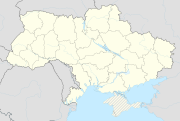Podusilna
| Podusilna | ||
| Подусільна | ||

|
|
|
| Basic data | ||
|---|---|---|
| Oblast : | Lviv Oblast | |
| Rajon : | Peremyshlyany district | |
| Height : | 327 m | |
| Area : | 2.9 km² | |
| Residents : | 316 (2001) | |
| Population density : | 109 inhabitants per km² | |
| Postcodes : | 81261 | |
| Area code : | +380 3263 | |
| Geographic location : | 49 ° 31 ' N , 24 ° 42' E | |
| KOATUU : | 4623385901 | |
| Administrative structure : | 1 village | |
| Address: | 81,200 с. Подусільна | |
| Statistical information | ||
|
|
||
Podusilna ( Ukrainian Подусільна ; Russian Подусельна , Polish Podusilna , formerly Usilna ) is a village in the western Ukrainian Lviv Oblast with about 300 inhabitants.
history
The place was mentioned in documents in 1462 as Vosylnye and later as Vszilne (1515) and Podusilna (1785 to 1788). The name is derived from the word usile (in Polish “effort, work”, Ukrainian всилання wsylannja / усилання usylannja ), possibly after the difficult to cultivate arable land, secondary Podusilna - pod ( Ukrainian під pid , German “under [half]”) Usilnem (see also the names Usilna ).
It initially belonged to the Lviv region in the Ruthenian Voivodeship of the aristocratic republic of Poland-Lithuania . During the first partition of Poland in 1772 the village became part of the new Kingdom of Galicia and Lodomeria of the Habsburg Empire (from 1804).
In 1872 a Mennonite settlement was established there . From 1909 they belonged to the municipality of Kiernica - Lemberg .
In 1900 the municipality Podusilna had 116 houses with 779 inhabitants, of which 738 Ruthenian-speaking, 28 Polish-speaking, 13 German-speaking, 743 Greek-Catholic, 19 Roman-Catholic, 16 Jews, 1 of other faiths. In the Podusilna estate there were an additional 31 houses with 248 inhabitants, of which 131 were Polish-speaking, 101 Ruthenian-speaking, 16 German-speaking, 123 Greek-Catholic, 70 Roman-Catholic, 5 Jews and 50 of other faiths ( Mennonites ).
After the end of the Polish-Ukrainian War in 1919, the community became part of Poland. In 1921 it had 187 houses with 1,046 inhabitants, of which 746 Ruthenians, 300 Poles, 837 Greek Catholics, 175 Roman Catholics, 22 Jews (religion), 2 Protestants, 10 other Christians. In the Podusilna estate there were also 5 houses with 49 inhabitants, 39 of them Poles, 10 Ruthenians, 25 Roman Catholics, 14 Greek Catholics, 9 Jews (religion).
In the Second World War , the place belonged first to the Soviet Union and from 1941 to the General Government , from 1945 back to the Soviet Union, now part of the Ukraine .
Web links
- Podusilna . In: Filip Sulimierski, Władysław Walewski (eds.): Słownik geograficzny Królestwa Polskiego i innych krajów słowiańskich . tape 8 : Perepiatycha – Pożajście . Walewskiego, Warsaw 1887, p. 476 (Polish, edu.pl ).
Individual evidence
- ^ Anna Czapla: Nazwy miejscowości historycznej ziemi lwowskiej [The names of the localities of the historical Lviv country] . Towarzystwo Naukowe Katolickiego Uniwersytetu Lubelskiego Jana Pawła II, Lublin 2011, ISBN 978-83-7306-542-0 , p. 155 (Polish).
- ↑ Księgi metrykalne i akta parafii i gmin różnych wyznań i obrządków (Ormianie, Autokefaliczna Cerkiew Prawosławna, Baptyści, Mennonici, Ewangeliczni Chrześcijanie) z terenów tzw. zabużańskich Inwentarz zespołu PL, 1 456 ( pl ) agad.gov.pl.
- ↑ Ludwig Patryn (Ed.): Community encyclopedia of the kingdoms and countries represented in the Reichsrat, edited on the basis of the results of the census of December 31, 1900, XII. Galicia . Vienna 1907 ( online ).
- ↑ Główny Urząd Statystyczny: Skorowidz miejscowości Rzeczypospolitej Polskiej. Województwo tarnopolskie . Warszawa 1928 (Polish, online [PDF]).


